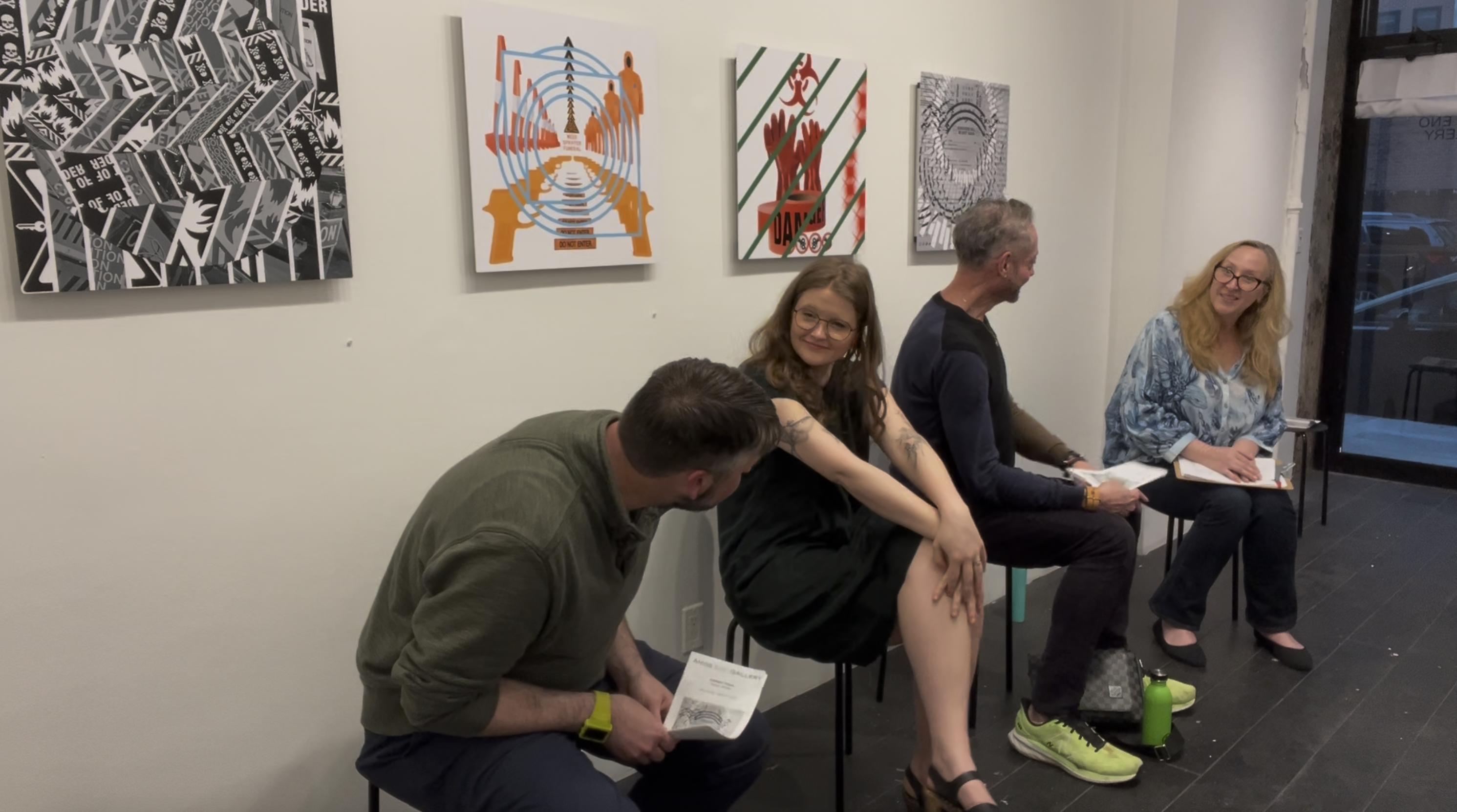On the occasion of the closing of Aaron Wilder's solo exhibition Contact Traces at Amos Eno Gallery in New York, fellow artists James Horner and Julianne Nash joined Wilder on a panel discussing the COVID-19 pandemic's impacts on them and their artistic practices. Amos Eno Gallery director and artist Ellen Sturm Niz moderated the panel discussion in the gallery on April 25, 2025. A recording of the panel is viewable on Vimeo and a transcript is below.
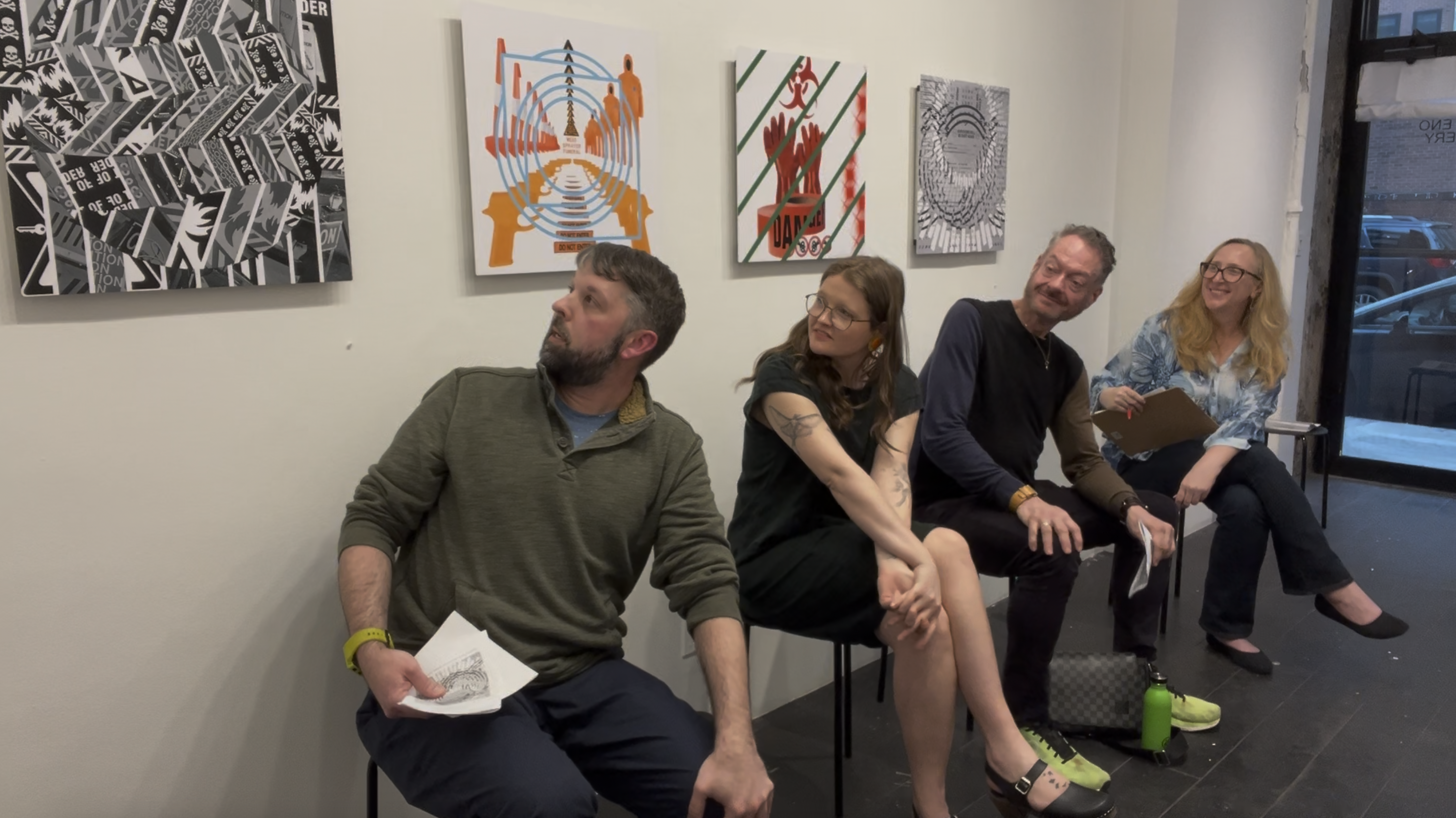
Ellen Sturm Niz: Hello and welcome to the “Contact Traces” panel discussion. Thank you for joining us. “Contact Traces” is an exhibition by artist Aaron Wilder. He is a member here at Amos Eno. We are an artist-run gallery that’s been in existence for 50 years. My name is Ellen Niz, I’m the director here and I’ll be moderating the discussion with our panelists. We’re going to reflect on the themes of the exhibition, discuss the role of art in processing personal and collective experiences, especially in the wake of the COVID-19 pandemic, and explore how isolation, transition, and resilience have shaped our creative practices. Through “Contact Traces,” Aaron explores these themes and tonight we’re going to expand on the dialogue with artists who navigated the pandemic in unique ways through their practices. Before we get started I’m going to introduce the artists. Aaron Wilder is an interdisciplinary artist whose work explores identity, memory, and the layered effects of isolation and relocation. His artistic journey has taken him across multiple cities from Phoenix to San Francisco to Chicago and now Roswell, New Mexico where he continues his practice. He has often found himself in places where he has no close contacts, shaping a deep engagement with themes of displacement and adaptation. His work is what you see here in all the walls in this space and the walls of the back gallery where he has smaller works for sale and a video installation. This is James Horner, a figurative painter, printmaker, and zine publisher who documents LGBTQ+ history and identity. James’ work is deeply personal, reflecting his experience navigating grief, loss, and community. And here we have Julianne Nash, a photographer whose work explores personal history, trauma, and ecology. She has used her art to process personal trauma, isolation, and the evolving relationship between the self and the outside world. Her projects, including “The Exiles” and “A Preternatural Paradigm” investigate memory, mental health, and our relationship with nature. In addition to being the director here, I am also an artist. I do photography, sculpture, assemblage, watercolor, anything I want to play with. My work explores many, many themes, often my own personal trauma, history, and issues and also just trying to find a way to play and find joy in life. We’re going to start with Aaron. Your work has been shaped by multiple relocations and you’ve spoken about isolation as a recurring theme in your life even before the pandemic. Can you give us an overview of the show as a whole and the work you chose to include in it?
Aaron Wilder: Sure. So, the work in the show was not created during the pandemic. During the shelter-in-place I didn’t create work about the pandemic because I couldn’t process it. While it was going on I focused on other things, or tried to focus on other things. So, the work that is in the show is from before and after that intersects with elements that relate to the pandemic. So, the work that’s over here is called “Social Boundaries.” These are from 2018. I started the project in 2016. It’s a series of photographs of barriers along neighborhood boundaries in San Francisco. The video piece that’s off right now because of sound is also from before the pandemic. The works here on the shelves are about processing my departure from San Francisco at the onset of the pandemic under circumstances that were out of my control. The drawings are on test prints, darkroom test prints, that I had carried with me through multiple relocations across the country and I asked myself why I had kept them. As themselves, the test prints are not really of value. I realized I had kept them because I had yet to process that aspect of the beginning of the pandemic. I made those in 2023. And then these behind us are the most recent work in the show from 2024. They intersect with a number of different types… It’s called “Abundance of Caution.” The name takes its cue from a phrase that existed before the pandemic, but was used extensively during the pandemic. It explores a number of kinds of hazards. The one with the red and green is “PPE,” so that’s the one that most directly relates to themes of the pandemic. They’re related to all sorts of different aspects of caution. The one on the far right has to do with gun violence. So, yeah, I think that answers your question.
Ellen: Yes, it does.
Aaron: Okay.
Ellen: When you did start to process the pandemic, how did that amplify or shift your experience of isolation that you have felt in different stages?
Aaron: At the beginning of the pandemic, as I mentioned, I was in San Francisco. Right before the pandemic I had been in a solo exhibition at the InsideOut in Sacramento, California, for which I created the video around the corner here. I also had cobbled together a number of part-time jobs in the Bay Area. I slowly, only partially due to the pandemic, lost all of them between December 2019 and April 2020. Around that time as I was working on “Social Boundaries,” the project over here, as “social distancing” became a term used more and more at the beginning of the pandemic, I felt very frustrated with that term, because, as someone living in San Francisco, a former classmate of mine described the feeling of living there as living in an elevator… I imagine people in New York can relate to that… where you’re living in close proximity to people and you’re pretending the other people aren’t there as like being in an elevator. I felt that before the pandemic San Francisco had too much social distancing, so that term really struck a chord with me. That sort of set me off on this sort of negative trajectory as far as the terminology that was being used. I continued exploring this project during the pandemic as I mentioned it was a time when I couldn’t really focus on the pandemic’s effects on me personally, just because I couldn’t allow myself to do it. I had tons and tons and tons of these photographs I hadn’t processed and so I continued to work on those throughout the pandemic in thinking about that phrase is used and how that’s related to these barriers in between us. Then I moved to Chicago. In Chicago, I was only there for a year and a half. I moved there, because I got offered a job there. It was my only offer of employment. My options were that or to be homeless in San Francisco, so I moved to Chicago. One of the works in here, in the zine that James and Julianne put together, this blue one… There was this project I started in 2017 called “Details,” which is looking at very minute aspects that we encounter in our daily lives. In Chicago, during the shelter-in-place, I moved there for a job to work remotely. So, it was completely ridiculous for me to move to Chicago, but, of course, at the beginning of the pandemic we didn’t know…
Ellen: How long it was going to be a pandemic!
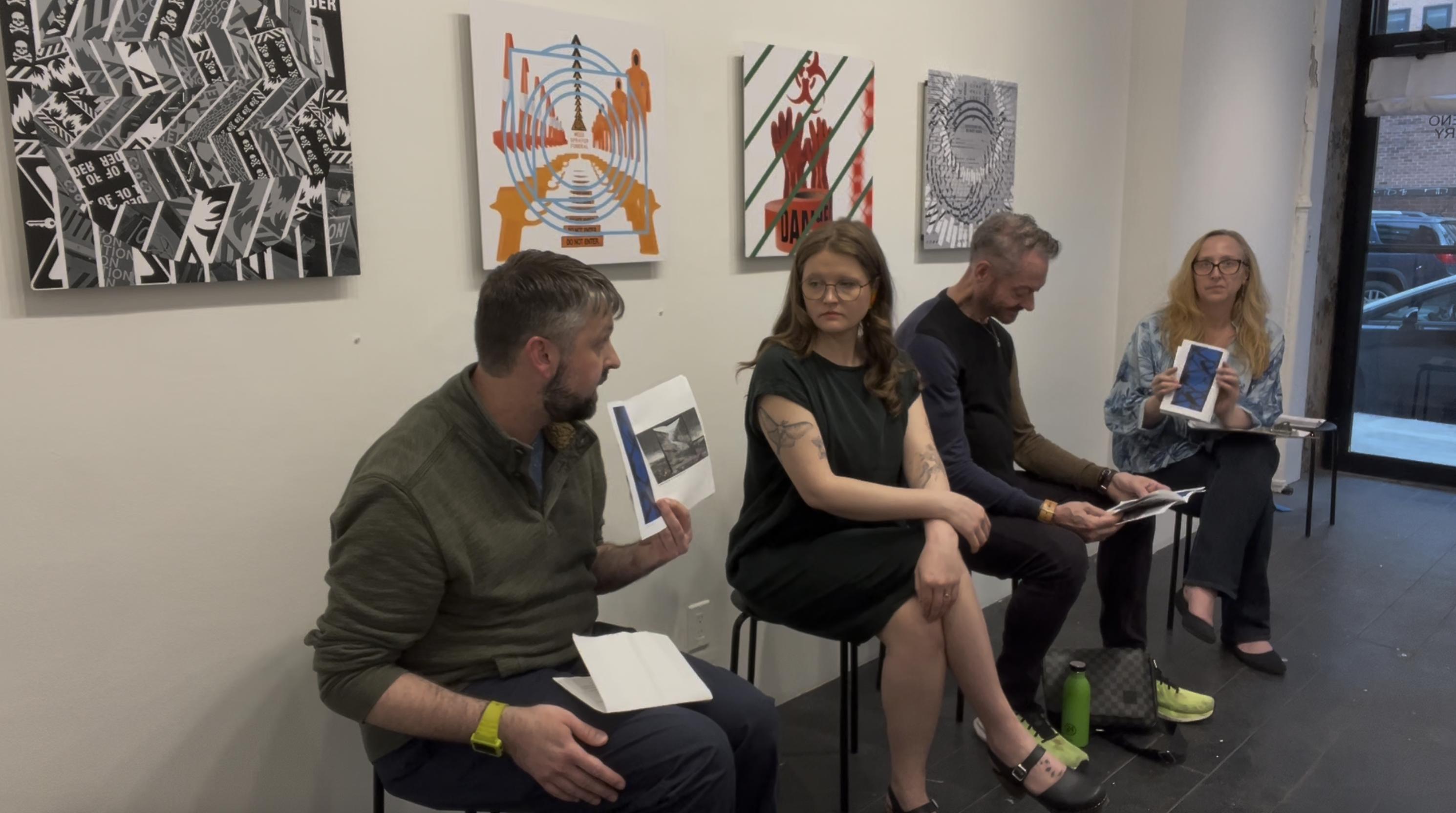
Aaron: Or how long I was going to be remote for! In retrospect, there was no reason for me to move to Chicago, but that’s hindsight for you. So, while I was there, because I really didn’t know anyone in Chicago, I would just walk around and take pictures with my cell phone. Some of them were videos. So, this is actually a still from a video outside one of the CTA stations… like the MTA for Chicago… that is this bus flashing blue light that sort of changes on this chain link fence that sort of flashes. So, this is an example of me dealing with an aspect of me living somewhere where I didn’t know anyone and trying to make artwork that wasn’t about living somewhere where I didn’t know anybody, ha! With what I had at hand, which is whatever I found. So then I moved from Chicago to Roswell with its own set of isolation for other reasons. That’s where I finally started to allow myself to process things. I still haven’t processed living in Chicago for that time. I still have a lot of processing to do about that, but I at least started to process, with “Before Exile,” my departure from San Francisco. That, at least, began the process of thinking about what the personal impact on me was.
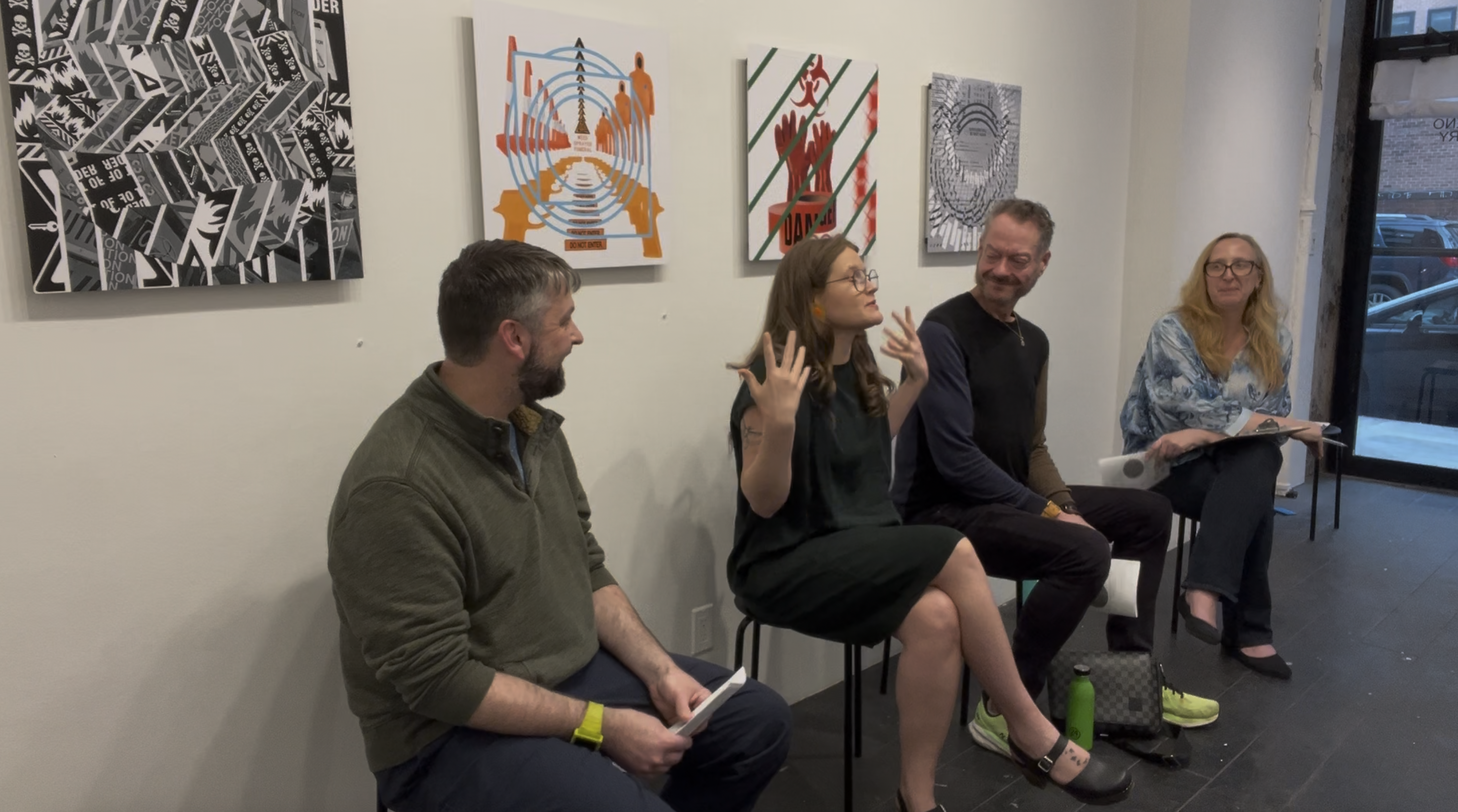
Ellen: Julianne, can you tell us a little bit about where you were artistically and personally at the start of the pandemic and how that experience was for you?
Julianne Nash: Before COVID I was working as an artist’s assistant and a bartender. I felt like my career… I was two years out of grad school and I felt like I was just starting to reach some momentum out of school. I was about to be published in a book by one of my professors and I was so excited, thinking this book was going to be the thing that changes it. Because the world changed, everything was delayed. I was remote, so I definitely felt like I took a huge downturn on my career.
Ellen: Were you expecting there to be a book party?
Julianne: Yes! I was expecting, “This is going to be my moment, guys!” And it certainly wasn’t. And then, within the first month of our shelter-in-place I was subleasing a studio from someone who was like “I have to move out of the city.” So, all of our five people that were subleasing from him all had to move out. I threw my stuff in storage at the time. I did manage to get another studio for a little bit of time, for one more year after that, but got priced out inevitably. I live in Gowanus and the studios there were insane now. In terms for work, I struggled with my day jobs going into COVID, because I was working for an artist who had a trust fund who was out staying in a vacation home in the Hamptons for a good year and a half. I was coming into the city and doing her work for her and going home and bartending at a place where I was just like “Why am I risking my life for this?!” We were doing the outside dining at the time. It was like ten degrees outside. I had to be drinking liquor to keep myself warm, because I couldn’t stay warm. I was growing the massive hatred of people. I guess I’m going down a sidetrack here! In terms of artwork… I had just come out of grad school. I finished the stuff I was working on. I didn’t necessarily have an idea. So, COVID hit and I didn’t have any pictures to work with. I layer pictures, I play with them in Photoshop, and use algorithms and stuff to combine them. There was one day I just spent, I think a full day, clicking around GoogleEarth and looking at places I wanted to be and wasn’t and just started taking screen grabs. After a little while I… Whenever I use pictures that aren’t ones that I’ve taken with a camera myself I generally like them to come from some type of database or GoogleEarth or something that’s for people to gather, not Google itself. I like to have them be in catalogues, I guess. I started downloading pictures from the United Fish and Wildlife database, which our taxpayer dollars go to images being put there and downloading all the ones that had #climatechange. And then I started layering those on pictures from GoogleEarth. And I was… As somebody whose work is about climate, I was having a really hard time with the fact that COVID happened, in and of itself, because of the way we treat our planet. A lot of reasons went into why we had a global pandemic. Deforestation was at the heart of that. I didn’t make the work of “A Preternatural Paradigm” with the intent of doing anything with it. I was really, for lack of a better word, fucking around on a computer…
Ellen: Right.
Julianne: … to fill the time. I included “The Exiles” work, because I feel that’s where I processed all the things we’re talking about. That work is deeply personal. It goes on a therapy journey that started a year prior for, shall we say, my complicated childhood and its effects on me. With all the things weighing on me I couldn’t do anything more but faking happiness. I wasn’t happy.
Aaron: This one, right?

Julianne: Yeah. So that’s actually the start. It’s one of the first ones I made. The concept was just “I’m so sad” and a little dark hole was my sadness, but there was all these vines growing around it and I couldn’t get to it. My therapist couldn’t even get to it. I was just kind of creating these voids throughout the next year or two processing my personal fear, but also everything we’re talking about. I think COVID itself exasperated all of the inequities in all of our personal and collective traumas and feelings we’re having because of this time that was so unique. Did I answer all of your questions?
Ellen: I think you did! James, I’m going to ask you the same question.
James Horner: Yeah.
Ellen: Tell us a little about where you were artistically and personally at the start of the pandemic and how the pandemic evolved for you.
James: Yeah, sure. So yeah, I was working full-time and I had actually started a class at SVA, a painting class. So, this painting here is a painting I did right before the pandemic started. I was doing a lot of grotesque, kind of figurative work. I do remember during the pandemic I… When you were talking about something it brought me back… I couldn’t remember a lot of it. I had to look at photos. This was kind of an interesting exercise. I was like “What did I make?” I don’t remember these things.
Julianne: That’s part of it! It’s what protected us.
James: So, you know, I looked at the photos. I was like “Oh yeah, I took that class before.” And then it stopped because we couldn’t go to the class. I did a few watercolors of when things opened up a little bit when we had waiters and we went to cafes and whatever again. I still have on my thing a few paintings of people scanning menus, because that’s when all that became big.
Ellen: And we learned what a QR code was.
James: Yeah. I was like, “QR code?!” I wasn’t really doing a lot of work or anything serious. During the pandemic I was working. A friend of mine told me, she was like, “Oh yeah, you had to do work part-time, because you were having this horrible anxiety or something.” I was like, “Oh yeah, I forgot about that.” I couldn’t remember it. So I was on a half-time schedule or something and working 20 hours a week. And then, towards the end, my boyfriend killed himself. He was depressed and everything, but also working at home for him… I loved it, I didn’t want to go to the office again. But for him, he was like… Some people just can’t do well with that kind of being alone. In any event, he passed away. After that, it really kind of pushed me. I quit work. I’m a full-time artist now. I was like, “You can do it!” I really now make more serious work than before. I really didn’t have a direction before. I was kind of doing figurative work, but not sure why I was doing it. I would take a class and get involved in painting and like getting into this grotesque thing. And then I got to this point, where I was like the queer world and queer art, it was kind of like down played and it wasn’t important for some reasons and it’s kind of come back again. So I thought, “I can do nude guys, I can do this kind of work, and it feels good again.” I kind of focused on queer art and. So, this painting is of me and my boyfriend sleeping. I had an SVA residency at the time and I did a bunch of paintings. And then I kind of continued with doing figurative work and focusing on queer icons and artists and other people that were supporting queer people and their fight during AIDS and things like that. I lived through the AIDS epidemic. It was kind of like the same thing only worse, because it was like, “it’s only gay people, they don’t matter.” It was pretty crazy to see all your friends die like that during that time. I had really gotten into this and I had been looking back into artists and artwork of time like the 80s. There’s a museum called the Leslie Lohman Museum and I’ve been in some shows there with some different groups. What’s really interesting is I went to one show once and they had this artist who was making these paintings with barely any nudity or anything, but they were about men going to the dirty movie theaters. So it would be like guys sitting here at a screening or something and so they had a video of this artist going to a gallerist, and he was totally gay too, and he was like, “Oh, there’s no market for this kind of artwork.” At the time, it was like an AIDS stigma, like “No, we can’t touch that, we can’t talk about it.” It was like a bad topic. It was interesting to see that, you know, all this artwork, and what the Leslie Lohman Museum did was collect all this stuff from people that died, so they’re still bringing it back and promoting it. So, the pandemic and my boyfriend passing pushed me into, you know, “I’m not getting any younger,” so I should really do this art thing if I’m going to do it and I’ve been having a great time with it. I’m in this gallery now and I’m doing a lot of projects. It’s going really well.
Aaron: Do you think your boyfriend’s passing was the single greatest contributing factor to you going forward as a full-time artist?
James: It really did push me. I was going to possibly retire would move out of the city. Because I also moved out of the city, just because it’s cheaper and everything. And he would keep an apartment here and I’d get a place out in the burbs or somewhere. But I think it really pushed me. I was also having a relationship that was pretty tumultuous, which was a lot. I wasn’t focusing on my work as much. I would take a class maybe. But now, that’s totally all I do is work with projects and art. It was probably a big catalyst in pushing me to take a chance and do this.
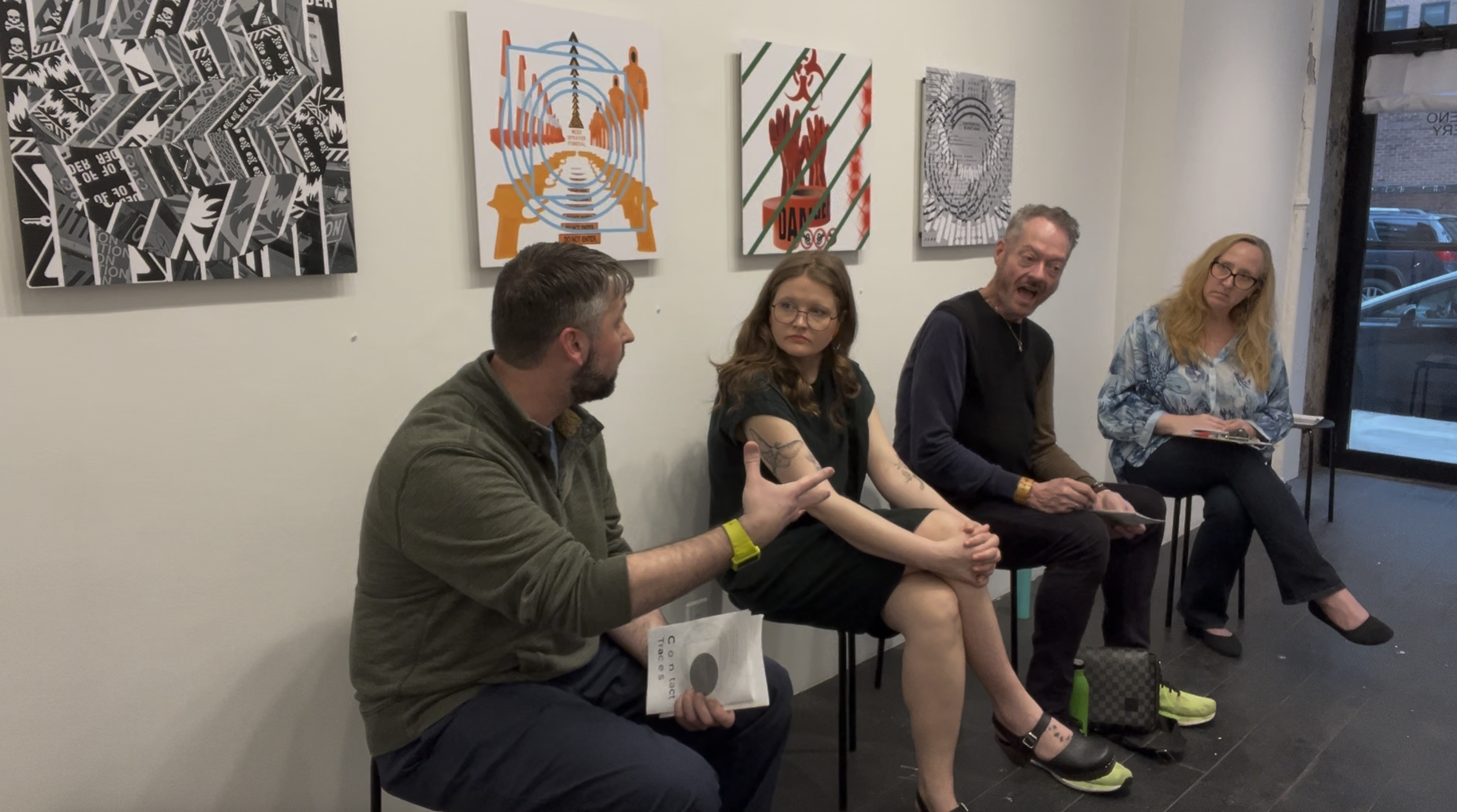
Ellen: During the pandemic I have a daughter who was finishing middle school when the pandemic started and I was working a couple part-time jobs at the time. I was actually excited when the pandemic started at first, because one of the part-time jobs I didn’t want to be working anymore and it was a great excuse to just sort of bow out of that situation. In the beginning I really enjoyed the free time I had. I reorganized a whole book case in my apartment. I realized that was anxiety-driven. I was just so, “I have to do something.” So I was meticulously organizing things around the house. I was excited to have more free time just to spend with my family and with my daughter although we’re all only-children, my husband, my daughter, and I. So, we really need a lot of alone time. Most of the time we were spending during the pandemic we were each in separate rooms in our apartment doing our own things and we’d come together in the evening for dinner and watching TV or any just regular time. I has recently started, several years before the pandemic getting back into artwork and performing, which I had done when I was much, much younger. Due to the way I was raised, I felt “That’s not a real thing that adults do in life and you have to get a real job.” So, I worked as a writer and editor for many, many years. That industry changed so much I got out of it, which is why I was working a bunch of weird, part-time jobs to help make ends meet. I was starting to do art again for the first time as I was finding out: “who am I? I have a child. How does that change who I am?” So I used a lot of the time during the pandemic to continue playing with artwork. I had started doing improv like six to nine months before the pandemic started. That continued. We would do it on Zoom, which is a terrible, terrible way to do improv, but it was at least something. It felt like there was a community who’d meet up and say a few things and we’d play games online together at night sometimes. I also just sort of took the opportunity to do weird things, like this one on page five, “Portal.” In previous years I had been looking through the internet and finding crafting projects I could do and one of those was folding magazine pages and stringing them together and creating bowls and vessels out of them. This is something that I used that technique. I built an arch out of them and covered a canvas in them and used an original photograph and magazine images collaged together to make this portal. It’s small, it's like a foot in width and height and a couple inches deep. And it was like, “Oh look! Here’s a door I can escape through out of this pandemic, out of this apartment that I am stuck in most of the time.” It took forever, but I finally had the time to just sort of play and do things. On page ten there’s a piece called “w(R)apture.” I started taking weird materials and just doing my own version of readymades with them. These are some concrete tiles that I took and I was just dropping them on purpose and cracking them in different ways and using these faux leather laces to reassemble them back together. Photography as well… I was like, “That is something I can do no matter what.” So I started taking pictures again and more frequently and really focusing on those and using them in collages. It was a surprisingly fruitful time for me artistically, but also weird, because I feel I was creating a lot of stuff, but without a community of artists around me for the most part and without any way to go and see. There were online exhibitions and viewing rooms, but that’s obviously not the same.
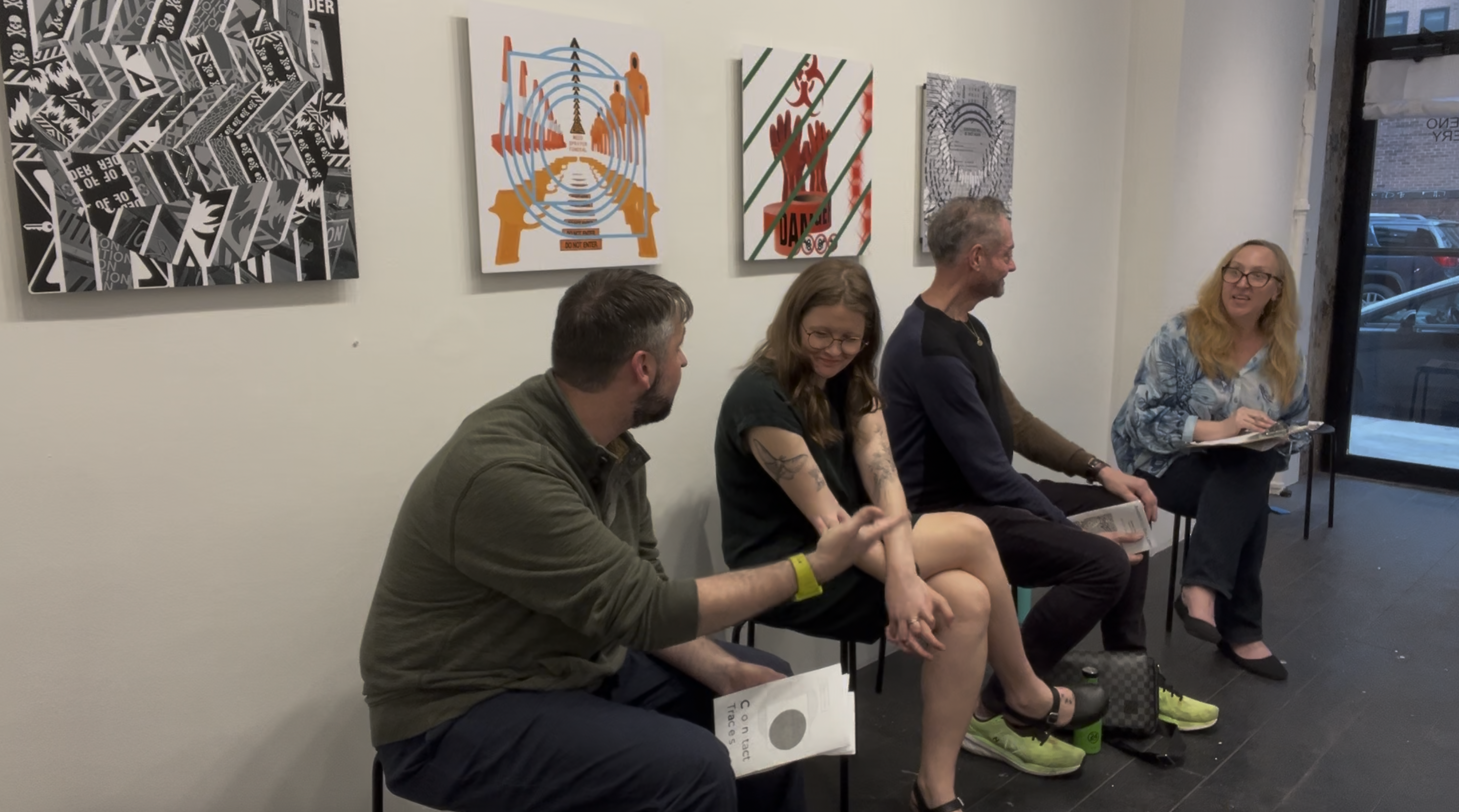
Aaron: Would you say that… Sorry, is it okay to just pop in with questions?
Ellen: Please, yes, of course!
Aaron: Would you say it’s somewhat similar to, as you said, your anxiety-driven organization of the book shelves… do you see these kinds of projects, where you were taking materials apart and putting them back together as a way of establishing a sense of control?
Ellen: I’m sure, absolutely sure. That was part of it. I definitely have a lot of control freak tendencies. I like things to be a certain way.
Aaron: I just meant as far as the situation of the pandemic and not having control.
Ellen: And the pandemic felt so untethering. It was like, “What is going to happen?” I moved to New York from Ohio when I was 22. All of my family lives elsewhere. I was like “How and I going to see my parents? How am I going to see my grandmother, who is very old and has dementia and it’s getting worse and worse? I can’t go see them and they can’t come see me.” I was constantly trying to make travel plans and my husband was like, “You can’t do that.” And I was like, “But we have to.” So I was like, “Well, I guess I’ll just have to break things and put them back together. How can I turn this into something?” That was definitely part of it.
Aaron: It’s both destruction and mending.
Ellen: Yeah, definitely. Let’s see… I feel like we’ve talked about so much. So James, your art often serves as a form of historical documentation for queer communities and you mentioned a little bit about how the pandemic made you focus more on that again and sort of make that the center point of the work you’re doing now. Did you feel isolated from queer communities and the arts world during the pandemic or did you still have a sense of community?
James: I think I had a community. I kept in touch with all my friends and family. I think a lot of it came out of pushing it away when I was younger. Not that I had this huge desire to focus on it, but I think with my boyfriend passing away and I found out too there’s a lot of queer youths who killed themselves…. There was a lot of suicide around queer people and whatnot. I think he had problems with being gay, because his family was not really that accepting of it. They were tolerant, like it was fine, but it was not the best. I didn’t really participate in a lot of stuff that was going on like in the AIDS crisis, like ACT UP. I just was not mature enough to handle that kind of stuff. I was just a stupid college kid, just going to clubs and whatever. I didn’t feel like I had really done enough. I feel like now I’m older. So, I’m learning a lot about history. A lot of these artists I’m looking at and researching… I’ve been doing a lot of that. I just did a zine about a bunch of these artists. I was kind of researching them. It’s just interesting. I like to learn history. I like that time period. It’s interesting for me, because I grew up during it. Now, I’ve found a place where I can focus and do stuff I really like. You know, I’m pushing the boundaries some of nudity and things like that. It’s so not me, but I kind of feel like it’s good. Like, “What am I afraid of?” I don’t have a job anymore. I don’t have to worry about politics. I’m not going to be a president or anything. I don’t think it even matters anymore.
Ellen: I think you could be president!
James: At this point I don’t think anyone cares.
Ellen: I think anyone can be president.
Julianne: The bar is so low!
James: It’s been going really well. I’ve been getting involved in a lot of different groups and just having a great time. I don’t make much money, but it’s all good. Someday, maybe.
Ellen: And Julianne, how about you? How has your artwork changed? How have found yourself prioritizing anything different in your work or developing different communities since the pandemic?
Julianne: Well, definitely this community. Losing my studio was part of my decision to join this gallery.
Ellen: And we’re happy to have you!
Julianne: I was like, “This is a lot cheaper than having a studio!” And this has some equity in it. Whereas the other one felt like an endless pit of money. I left a job at one point, the one I was working for the artist, kind of compulsively when I got this job close to my apartment at a still life photo studio. It did not go well. I kind of got personality fired, so it totally just shattered me as a person for about a year, feeling I’m awful at everything until I build myself up from nothing, which is part of where “The Exiles” grew. With COVID, I had been diagnosed with complex trauma for a long time and my therapist was like, “You have PTSD.” It took about two years working with her to realize I also had OCD, which came out of the pandemic and heightened a lot of cleaning tendencies, compulsive tendencies. My thing is skin picking, so I was picking all over. I was a disaster. Making those “The Exiles…” There’s only one here, but that one is really compacted. Over those two years, it became like flowing water as I worked through all this stuff. And then it became a representation of my growth, so as I looked at that I felt that I could then go off and accomplish more and I gained that confidence back. I’m working for a florist and I take pictures for her. It’s the first time I’ve had a fulfilling work environment. I work with really nice women who… only one guy, mostly all women… who are so supportive and I get to really be myself. I feel that “Oh, that personality fired I got, here’s that me personality flourishing.” It’s been very fulfilling to be my nerdy self. So, I feel my life changed completely in the way I work. In the past year I’ve been working towards my show coming up in a couple months, but also a book of ten years of work. All of the stuff you see here and stuff from grad school up to now and that just came out last week, so that’s exciting.
Ellen: Congratulations!
Julianne: Thank you! I’m very excited about that. It finally feels like that my career’s going to come back up a little.
Ellen: And the images on page two and four are untitled images from 2020…
Julianne: Those are the ones from that month-long shelter-in-place.
Ellen: The Fish and Wildlife…
Julianne: Yeah, I was watching a lot of documentaries at the time about the planet and it was like “I want to learn in this time.” I think all of it made me so anxious I was just hastily making things. I really didn’t think they were going to be something I would stand by.
Ellen: They’re beautiful.
Julianne: Later I was like, “Oh, I can really see a lot in them.” And actually liked it. But I really thought they were just going to go in COVID stacks in a folder that got made in my computer like they were boring to me at first. It’s interesting how you kind of process the thing you realize, “I was actually really saying something about how scared I was, about how we’re going to have more pandemics, because we’re just going to continue to destroy our planet and more species are going to pass diseases to us and it’s a full cycle.
Ellen: During the pandemic one of the women I did improv with, she’s really into virtual reality and she had a ton of virtual reality headsets. She would lend them out and I remember going to her house. So I was meeting her outside like a handoff to get her VR headset and then I went home and it’s like there’s all kinds of virtual reality things you can do, but most of what I did was go on GoogleEarth and walk through.
Julianne: I would literally click down the trails and think, “This is so fun!”
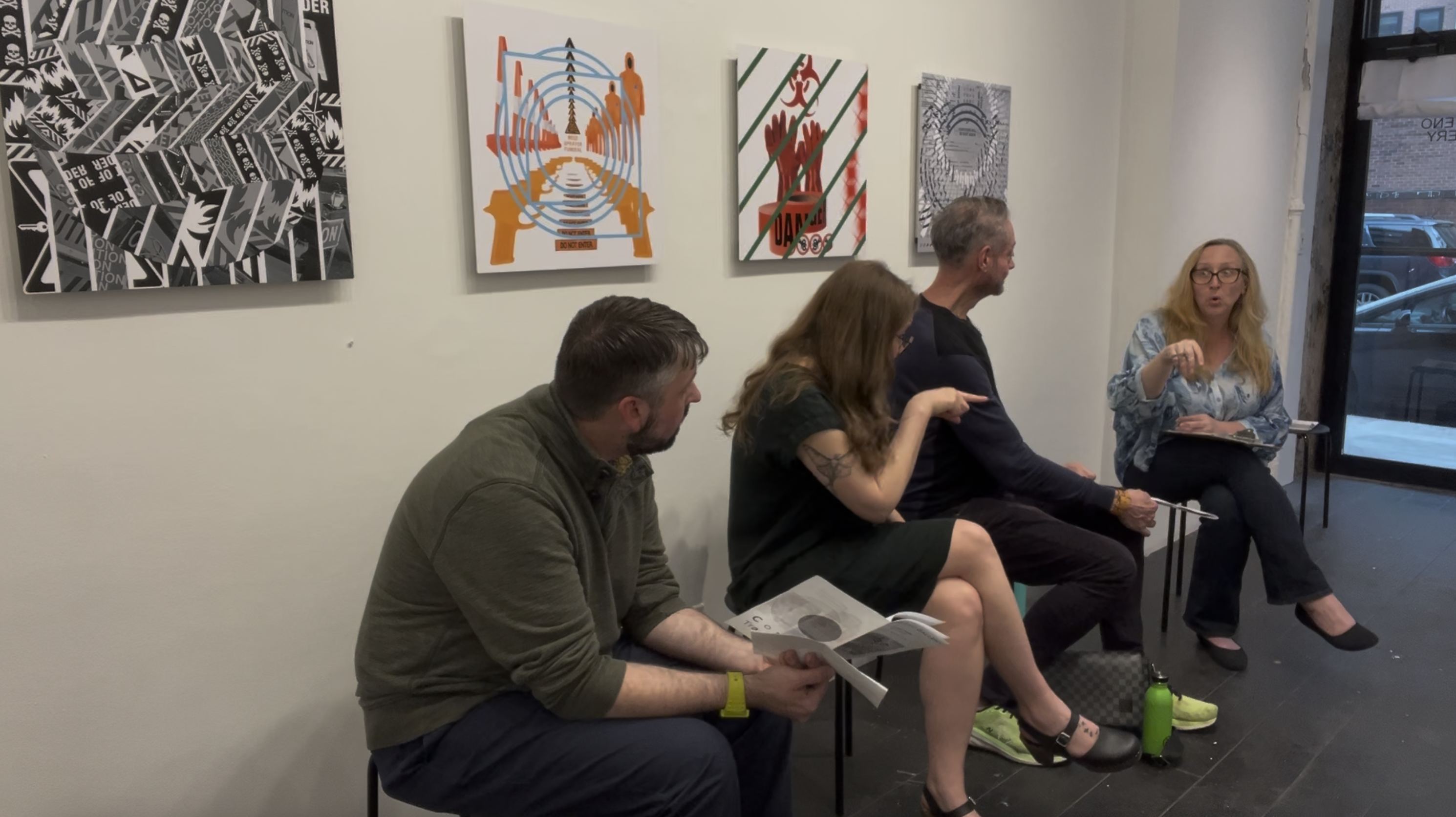
Ellen: Right. I’d be in the VR headset and one of the places I kept going to was my childhood house.
Julianne: Weird!
Ellen: My parents didn’t get divorced until I was 24. They sold the house then and it was very sudden. I was like, “Oh, I still have a lot of things still to work through!” I would keep taking this VR back to where I lived.
Julianne: And you can see old years.
Ellen: The pandemic really put a lot of things into perspective, highlighting the things we haven’t dealt with in years.
Julianne: For sure!
Ellen: And also highlighting the things that I don’t need to be hung up on anymore. It’s like, “Who needs a full-time job?”
Julianne: I spent a full year unemployed. I call it my “floor time.” I feel like I spent an entire year just sitting on the floor, because I was just not doing well.
Ellen: Right, yeah!
Julianne: Just stretching, trying to get the sadness out of me.

Ellen: And we all had kind of an excuse to take that time for ourselves and process things in a way that we wouldn’t have had the time to do otherwise. Aaron, do you have…?
Aaron: It seems… I was just going to say it seems like both with the trauma you were processing and with “The Exiles” you were stripping everything, yourself down to a very root place.
Julianne: Yes!
Aaron: And then building back up.
Julianne: It’s based on a therapy practice called “parts work.” So you exile parts of yourself and you have these protectors around them so you can’t get to that part of you. So, I can look at these and be like, “I was feeling like this at that time.” I can point to them and know what I was dealing with. I don’t necessarily like to go into detail with all I was dealing with.
Ellen: No, that’s really interesting. I’ve never heard about that before: parts work.
Julianne: It’s in “The Body Keeps the Score.”
Ellen: Oh yes! I have heard of that book. Let’s see… Where am I in my notes? I knew I was just going to have a guideline here. Let’s talk about audience engagement and the legacy of our work. Aaron, how do you think viewers of your work experience aspects of your perspective on the pandemic or just on the themes of isolation? Have you had any surprising reactions or interesting reactions from people?
Aaron: As far as reactions, not so much. At the opening, someone told me these need to be more political. I thought that was interesting. I said “Thank you for the feedback.”
Ellen: Yes.
Aaron: As far as this show goes, I tried to use juxtaposition as a way of creating links between things. I see these two bodies of works, “Social Boundaries” and “Abundance of Caution,” as being, sort of, juxtaposed next to each other and being very different in their compositions. One is this visual chaos, “Abundance of Caution,” and “Social Boundaries” is more formal with these rigid structures and rectangles and being sort of different cages. One is more of an explosion and the other is more of a container. Similarly, in the smaller room here there’s a greater sense of intimacy with being able to hold the small drawings and being able to… the video’s not on right now… but being able to see the video and the colors that relate to each other. I’m hoping the works in the back are more personal invitations to see something about yourself in some of the photographs and in the video. But, as far as feedback, I haven’t gotten a ton yet.
Ellen: Okay.
Aaron: Maybe tonight…
Ellen: Yes!
Aaron: We’ll see.
Ellen: Any final thoughts from anyone on the panel? Anything you wanted to talk about and feel like you didn’t before we open it up to questions from the audience?
Aaron: I did.
Ellen: Yeah.
Aaron: One thing I wanted to mention was about the process of moving from moving from San Francisco to Chicago to Roswell is this abrupt change from more social-oriented to more inward-oriented. I mentioned that the video in the small room here is from a solo exhibition I had at the InsideOut in Sacramento. That exhibition was called “Expletive Chapel: Lavender Heights.” Lavender Heights is the historical LGBTQ neighborhood in Sacramento and that exhibition was creating a chapel, a sort of safe, secure, holy place for the queer histories that existed in Sacramento. That involved doing a lot of research at a local institution called the Lavender Library, which is one of the oldest, at least in California, one of the oldest queer libraries that existed. I was also interviewing people whose lives intersected with that neighborhood in Sacramento. That was a very social-oriented project. “Social Boundaries,” at the time, was a very social project. I had a whole proposal with the city of San Francisco where I was going to map every single, eighty-something neighborhoods in San Francisco and photograph these kind of structures along every single neighborhood boundary. That grant proposal had gotten all the way to the San Francisco Arts Commission and I almost got it! But I didn’t. The two experiences, both the proposal getting so far in the process and the experience in Lavender Heights in Sacramento pushed me in this direction that I really was excited to go into. When I sort of plopped into Chicago without really having any connections to anyone I had proposed this social project. In retrospect I was really not only wanting to continue this social direction, but I really wanted to connect with people.
Ellen: Right.
Aaron: I had started working on this project exploring doing interviews about notions of masculinity across the gender spectrum. So, I had done this proposal with a residency called High Concept Labs. So, they funded the research for me to go through with this research and I started formulating all the interview questions. I started research on how to conduct interviews and all these things and all of the sudden I moved to Roswell. Roswell was a whole different kind of isolation from Chicago. Then I suddenly was afraid to do these interviews. I was like, “I can’t even say it’s about masculinity.” Because that’s automatically a target on my forehead.
Julianne: Yeah.
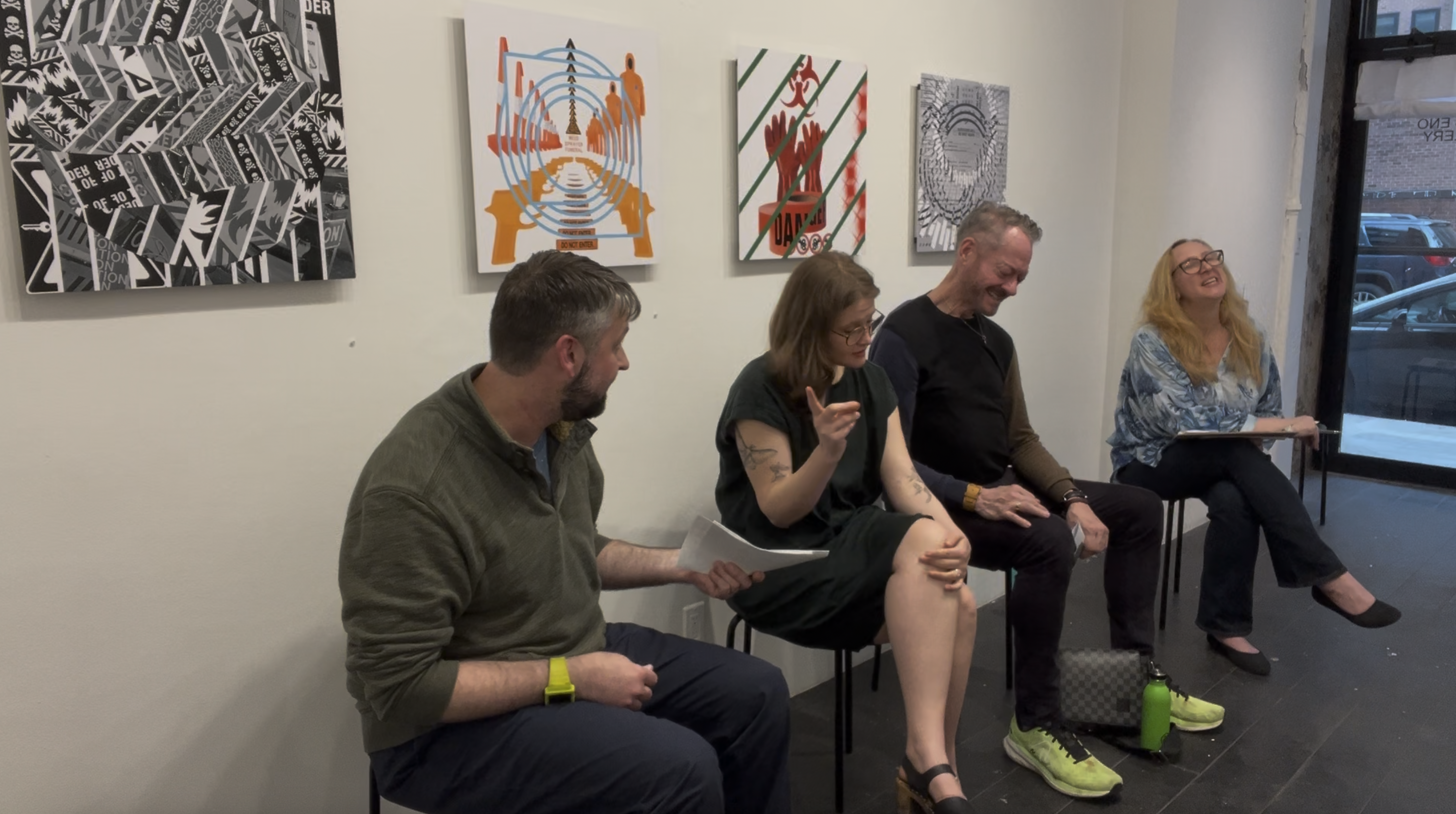
Aaron: So I was like, “I don’t know what to do with this.” I spent so much time working on this project and I just kind of shut down. I was like, “I don’t know what to do with this.” So I just put it to the side and that’s when “Before Exile” happened. I was turning completely inward and just focusing at that time on allowing myself to process this departure from San Francisco and that I didn’t want it to happen. I still feel like I’m in that internal area now. I want to get back to this interview project and I just don’t know how to do it. I’m like, “How can I be sneaky and not talk about it being about masculinity?” But it would be about masculinity, because that actually would be really interesting.
Ellen: That would be really interesting!
James: Yeah!
Aaron: But, how do I not get shot?
Ellen: Can you travel and do it somewhere other than Roswell? Where you could feel more comfortable, maybe?
Aaron: Sure, possibly.
Ellen: Possibly? The mean streets of New York, perhaps?
Aaron: I gotta get up the courage. That’s what I gotta do. I just wanted to mention that as this sort of trajectory that was going and then all of the sudden…
Ellen: Right.
Aaron: Wind removed from sails.
Ellen: It’s interesting, your exhibition and this panel discussion and I was recently in a ten-minute play in a short play festival that was focused on the pandemic and I feel as we’re hitting this five-year anniversary of the pandemic that there’s so much more to talk about it than there has been for a couple of years. When it was “over” it was like “great, let’s never talk about it ever again,” but I’ve been coming back and like, “actually, wait a minute, there were some things we didn’t really deal with about it, but we need to process…
Julianne: For sure!
Ellen: My daughter started college in the fall and it did not go well. She is back at home and doing fine. The play was actually about a mom getting a will made in case she should get COVID and die and how she wasn’t giving everything to her child, because the child was having a lot of mental health issues. I was playing the mom. As I was reading the script and rehearsing, I was like, “Oh, I have a lot of things I need to process about being the mom of a child who went through the pandemic and she did great in so many ways, but also it was a very difficult situation emotionally for her in middle school and then start high school without that social connection.
Julianne: Yeah.
Ellen: And sort of mourning as a parent not having those “regular experiences” that you expect you’re going to have with your child in high school, because none of it was what you expected. There was no first-year-of-school going to all of the performances and meeting the other parents and her getting to make new friends other than on Zoom, which is very weird. It’s really interesting to see how it’s all still percolating and, obviously, people are still dealing with it. We had an artist who came into the gallery recently and was looking at the exhibition and he shared that he had COVID and he showed me he had a scar on his neck from where he had been intubated and he was in a medically induced coma for two months…
Aaron: Wow!
Ellen: And barely survived. They didn’t tell his wife at the time and he didn’t know, obviously, until much later. Only 25% of the people… And he got COVID in 2021, so it was almost a year after… But only 25% of people who were intubated at that time actually made it through.
Julianne: Wow!
Ellen: His wife went to the hospital one day when he was in a coma with three other patients who were intubated in his little area and they were all gone, they had died. And she was like, “Oh, I didn’t think that was possible.” But he said it took him a long time to recover. It was very challenging, but it really changed his whole perspective on life. He was like, “I spent so much time on art before and I still love art, but I don’t spend nearly as much time now; I travel. My wife and I are traveling, because I’m not getting any younger and I want to see places, I want to go places. He said he was so worried about his art and having a brand that was recognizable before and making things a certain way. And now, he says “I just make whatever I want, I don’t give a fuck what anybody thinks about it.”
Julianne: I think that was a pretty common response.
James: Yeah!
Ellen: Everyone is going, “You know what? I have to do me!”
Julianne: All of this is made up!
Ellen: Exactly! You have to enjoy what you’re making and what you’re doing and process everything your own way. Okay, does anyone in the audience have anything they want to share about their experience of the pandemic or artwork or any questions? No? You’ve told them everything they need to know, guys!
Audience: I am just wanting Aaron to tell about his work a little bit.
Aaron: These ones?
Audience: Yeah. Especially the second…
Aaron: This one?
Audience: And the third. And maybe this and this.
Ellen: All of them, please.
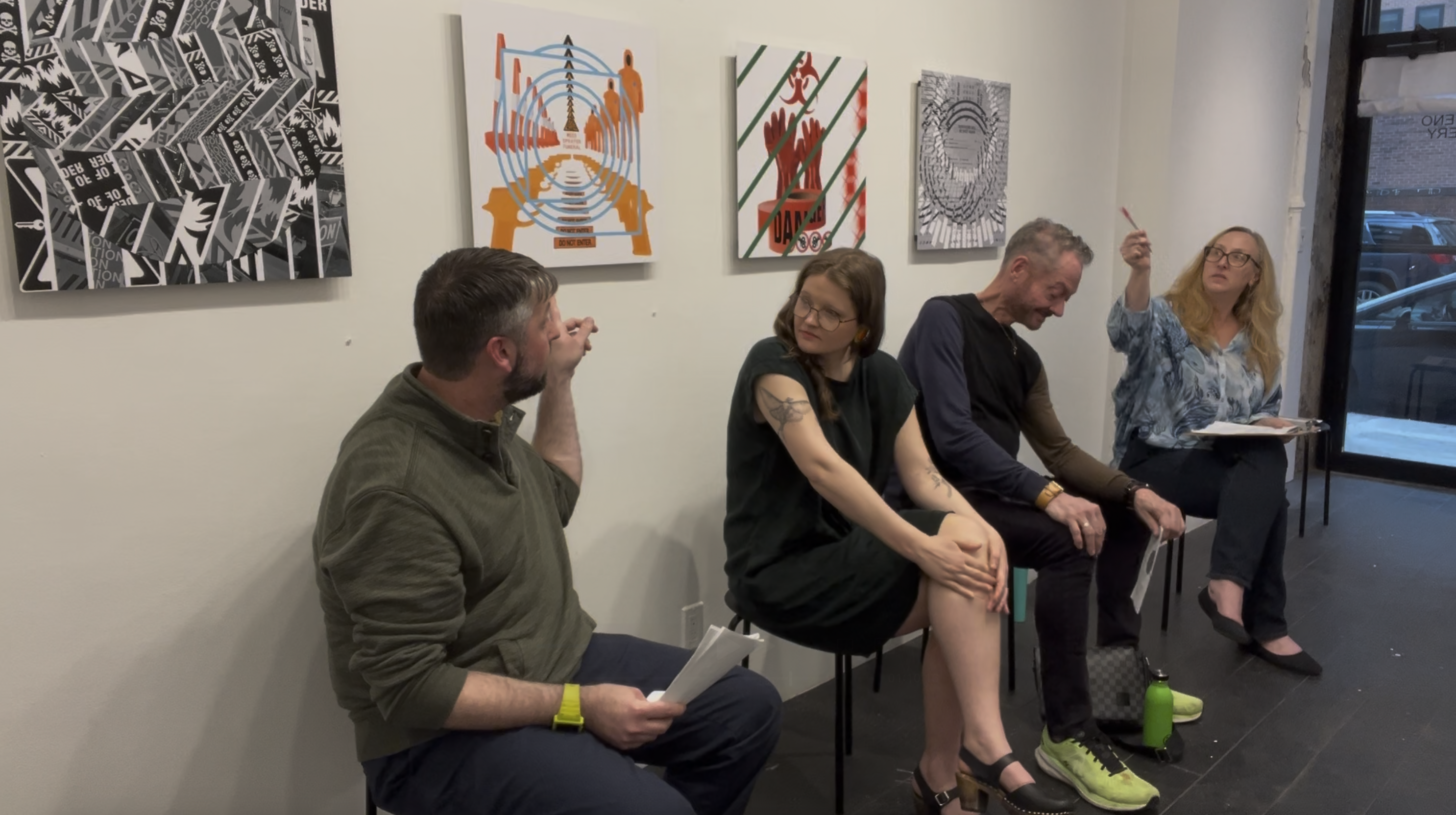
Aaron: This is a series, the most recent work in the show. This was specifically made for the show. This series was made last year. It’s more than just these. These are four of, I want to say maybe 16, 12-16 works. They are digital collages that are printed on aluminum. Another member, Grant Johnson, told me about Tribeca Print Works that he has his photographs printed at. This is the first time I’ve worked with this medium. So, I made these collages from different sourced material that are in different color schemes. From when I was in art school, a classmate of mine used this app called Fragment. I loved his work he made with Fragment. It’s the second app ever that I’ve paid for. I’m really big on not paying for apps.
Julianne: Same!
Aaron: And I never used it. I loved the work he created with it and it was just on my phone for a really long time. I kept thinking to myself, “You know, I really want to do something with that…” So, basically, there are two layers of collage. I made the collage, then I processed it twice through Fragment. The first time, you can kind of see these lines here that don’t have color where it’s kind of chopped and it kind of ripples coming out. That’s the first layer in Fragment, then adding the colors and shapes was the next layer in Fragment. So, I guess you could say it’s three collages. This is focusing on boundaries, but you can also think of chemical exposure.
Ellen: Is that inspired by the Bayer trial? Maybe subconsciously?
Aaron: Maybe a little bit. The one on the far right is called “Survivors Will Be Shot Again” and that, in some ways, is my experience living in Roswell. Gun-toting country.
Audience: But these colors are related to COVID?
Aaron: Not directly, no. The whole series is “Abundance of Caution,” so there are different types of caution. The one that’s here in the green and red is called “PPE” and so that’s looking at a number of different kinds of PPE, or personally protective equipment, something that was a key buzzword during the shelter-in-place. You can see the gloves which were a major aspect of PPE during the pandemic. And then there are things that are not really thought of as PPE. If you look at the red stars there’s a watermark by whoever the commercial company is who made the image, I’m thinking of the watermark as intellectual property as a type of personally protective equipment.
Ellen: Interesting.
Aaron: That’s just one of the lenses you could look at this work through. It was a departure point, different types of caution and what is an abundance of that caution look like. There’s a lot of fragmentation, chaos, and, again, it was meant to be basically opposite of the structure of this body of work. I don’t know if that answers your question, though.
Audience: What about that one?
Aaron: This one? This one is called “Out of Order.” This one is meant to be a little more ambiguous. So, it’s basically taking a bunch of different… this one also has a bunch of different warning signs and poison symbols. This one’s meant to be just more caution in general.
Audience: By printer, do you mean printer-printer? Or using real works to do some magic?
Aaron: I like that! It’s magic!
Ellen: Magic!

Aaron: I guess you could say I outsourced it to a company called Tribeca Print Works. So, I gave them the digital image. They used a process called dye-sublimation to print it on the aluminum.
Audience: Oh, okay. So, it’s a special machine?
Aaron: Yeah. I probably should know how you do dye-sublimation, but I don’t. It’s some way of adhering the ink to the surface.
Audience: Oh, okay. Can I ask, what’s the first app you paid for?
Aaron: HappyCow. It’s a vegan restaurant app.
Ellen: Nice!
Aaron: My sister made me. It was the first one I downloaded and I was very resistant, but she was an ambassador for HappyCow and she’s like, “Well, you’re vegetarian, so you clearly need to get this app.” So, only two ever. I’m going to keep it to two as long as I can.
Ellen: The data miners don’t know what to do with the fact that HappyCow and Fragment are the only two.
Aaron: I know!
Julianne: Yeah!
Aaron: What is the common denominator? I have no idea. They’re both influenced by other people too, it wasn’t just me looking for things.
Audience: So, thank you all for sharing your experiences. It’s interesting everyone had a theme conflicting with art being an outlet traditionally for being able to get out of such a claustrophobic experience and actually stifling. And essentially you showed how work before and after were change in how you express yourself. For you, you were using it to process how to move through it on your end. You couldn’t do expressively the work you wanted to do, so you did photos and you did other mediums in the meantime that you did process in other mediums. And James you did as well. You went to other mediums while you were understanding and processing and you got back and flourished back into more figurative art and whatnot. And for you as well, it was literally an escape and you could also work through some of these different tings. It’s interesting how your approaches to art differed and how you handled those moments of stress and the different relationships you had. I was curious, moving forward, have you each had… do you have the same stress, do you find yourself moving to the same mediums again or do you feel you’re going to what’s your primary language with art? Maybe starting with Ellen?
Ellen: Sure. I definitely struggled with when I sit down to make something or be artistic, thinking I have to make something amazing and can get in my own way a lot in that respect where what I’m going to create isn’t good enough, I’m not a “real artist,” because I didn’t go to art school and I’m almost fifty years old and only started between five and eight years ago with any sort of consistency. I have to keep reminding myself it doesn’t matter, you just have to do the work and it’s okay to make terrible things. You make enough terrible things and eventually something good happens. Honestly, every time I sit down and I think “This is terrible, you don’t know what you’re doing!” Then I’m like “No, stop. You are learning. You are trying. You are experimenting. You are playing.” So, I’m just trying to remember that I’m just playing and watercolor is something I started very recently and I’ve found that has been a really good thing to do every time I go to the studio is to do watercolor first, because it’s cheap, it’s easy, it’s quick, and you can make something terrible really fast and it sort of lets loose. Then I’ll have other ideas. It’s sort of meditative. It opens up my brain to just think about it. I really wanted to get away from working on a computer too much, so I have avoided some more significant photography, but I have found I do really miss it. So, I think that’s probably going to be something I really focus on this summer is going everywhere with a real camera and not just my iPhone and taking a lot more photographs that I can print, perhaps dye-sublimation on aluminum.
James: Yeah!
Ellen: Or use them in collages and assemblages.
Aaron: I will say, iPhones…
Ellen: They take some great pictures!
Aaron: I didn’t know you could take CameraRaw pictures with an iPhone now.
Ellen: Yeah! I mean, you can take really nice ones, but I feel like with my phone I still feel more snapshot-y and my big digital camera. It’s like, “Now I’m taking a ‘real’ photo!”
Aaron: I just mention that because I found out that my iPhone now takes much better photographs than my actual camera does.
Ellen: Yeah!
Aaron: It blew my mind.
Ellen: In my teens and early twenties I took a lot of on the street photos of people and as I’ve gotten older I’m much more resistant to that, because I don’t want to get yelled at or confronted. With my digital camera I have a really good zoom lens and I think I might be able to take surreptitious photos of people outside in a way that will make me feel more safe about it.
Julianne: People don’t know.
Ellen: I’m really good at that with the iPhone. James?
James: I’m traditionally a painter. Right after the pandemic I went into pottery and made these little sculptures. I was having a great time with that. I felt it was good, the whole sculpture process and working in a studio was like, eh, I just want to do something on my own. I did two classes. It was also good to do something in 3D, so it’s not always so flat. I’m going back to painting. I was telling Ellen, I did one painting in September for this last show. I did take a class with a copier machine that’s Japanese… What’s is called?
Aaron: Riso?
James: Riso! Which was really great. I had done a few different situations. This was all on riso, so I learned how to use it, but other than that, I’ve been doing some curating, I got this group together and did this exhibit in Chicago. I kind of like the idea of doing a certain amount of work and then using it for other things. I just did a zine with artwork I did in France. So now I think I need to start something new to put out there in some format. I also got that app, my sister Holly told me… It’s on the iPad, so digital. I had never really done a lot of that and I really enjoyed doing it. I’m still trying to get used to it. I want to do more of that, definitely. I thought it was cool, like taking a photo and then doing something on top of it. You know, just drawing.
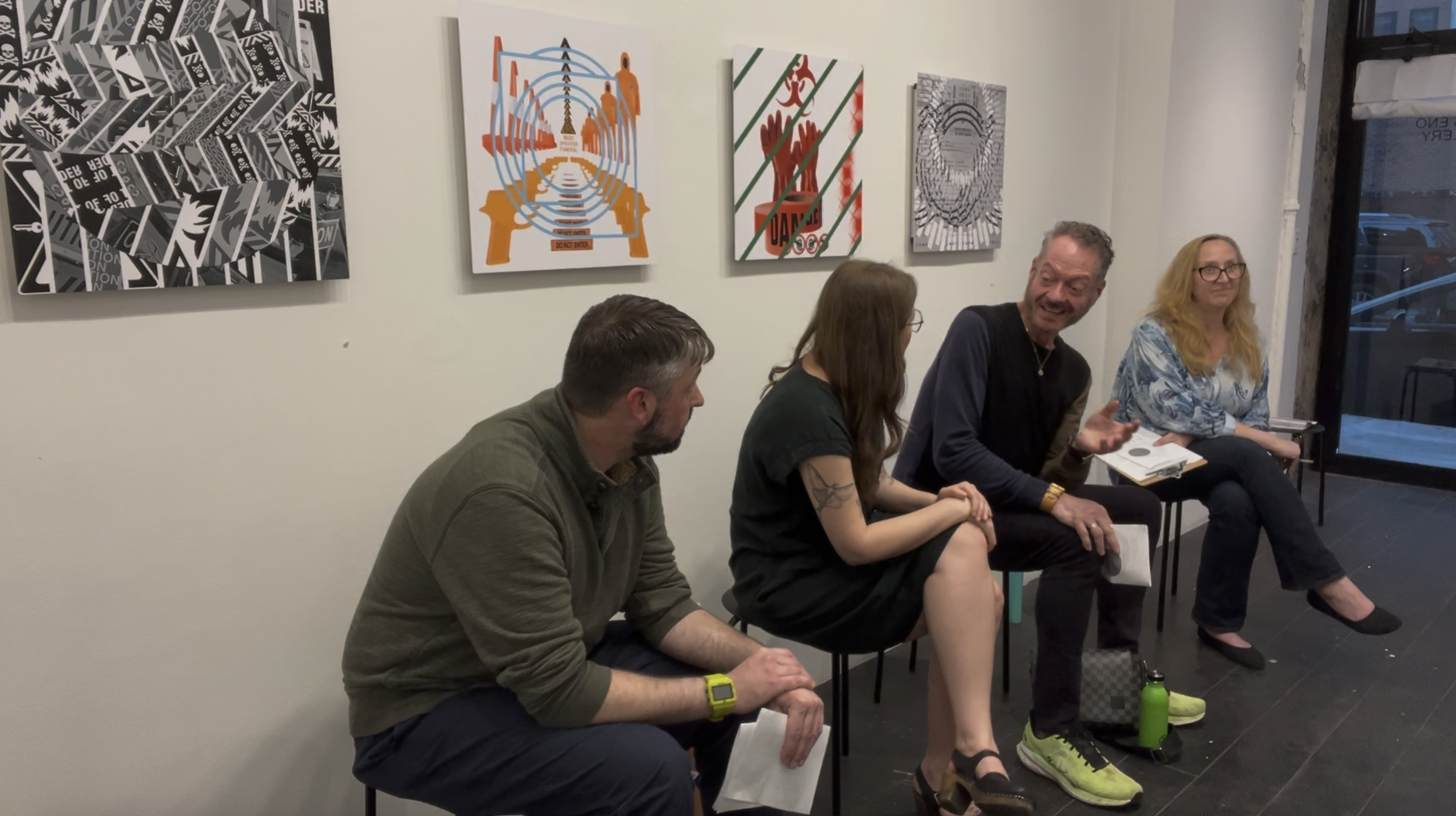
Julianne: I haven’t had a super productive year in terms of work, because my job-job is very creative right now. I’ve been making photographs with a florist for a book that we just published. I did have very fulfilling creative work in that way. The few things I have made of my own work—I’ve been trying to push myself to towards abstracting my style a little, which has been hard for me, a lot of flops here and there. I’m trying to push it less towards the personal and more towards the collective. I think collectively we have a lot of grief we’re experiencing, especially as climate is my main focus, but just all of our social issues come into it a little bit. I’m kind of pushing it in a new direction, I guess. We’ll see where it goes.
Ellen: You’re learning!
Julianne: Yeah!
Ellen: No flops; learning.
Aaron: I tend to gravitate toward photography. I’m someone who never calls myself a photographer. I think part of that is being surrounded by photographers in art school and they’re like “You are not a photographer!” I never learned the basics. I didn’t have sort of a BFA kind of experience to learn all the nuts and bolts of this is what a camera does, this and that, I just kind of flopped into it and just stumbled through it. So, I use photography as a primary medium in my practice and it’s become kind of a crutch, actually. It’s become kind of an easy thing to do, to default to photography now, or photo-based things like collage. And that’s something I’ve only recently become aware of. There are a number of things I want to do. I want to get back into sculpture and I’m afraid to do that, because there are so many things I don’t know how to do. There are so many processes I don’t know how to do; I don’t even know how to start doing. But I used to work in sculpture and I’m trying to figure out a way to get myself unafraid to go in that direction. And there’s also this social practice mode of work I had been moving up into and then just terminated and I’m trying to figure out how to get back to that.
Audience: Julianne, sorry, maybe you already told, but before pandemic your theme changed very much?
James: Um…
Audience: No, Julianne first.
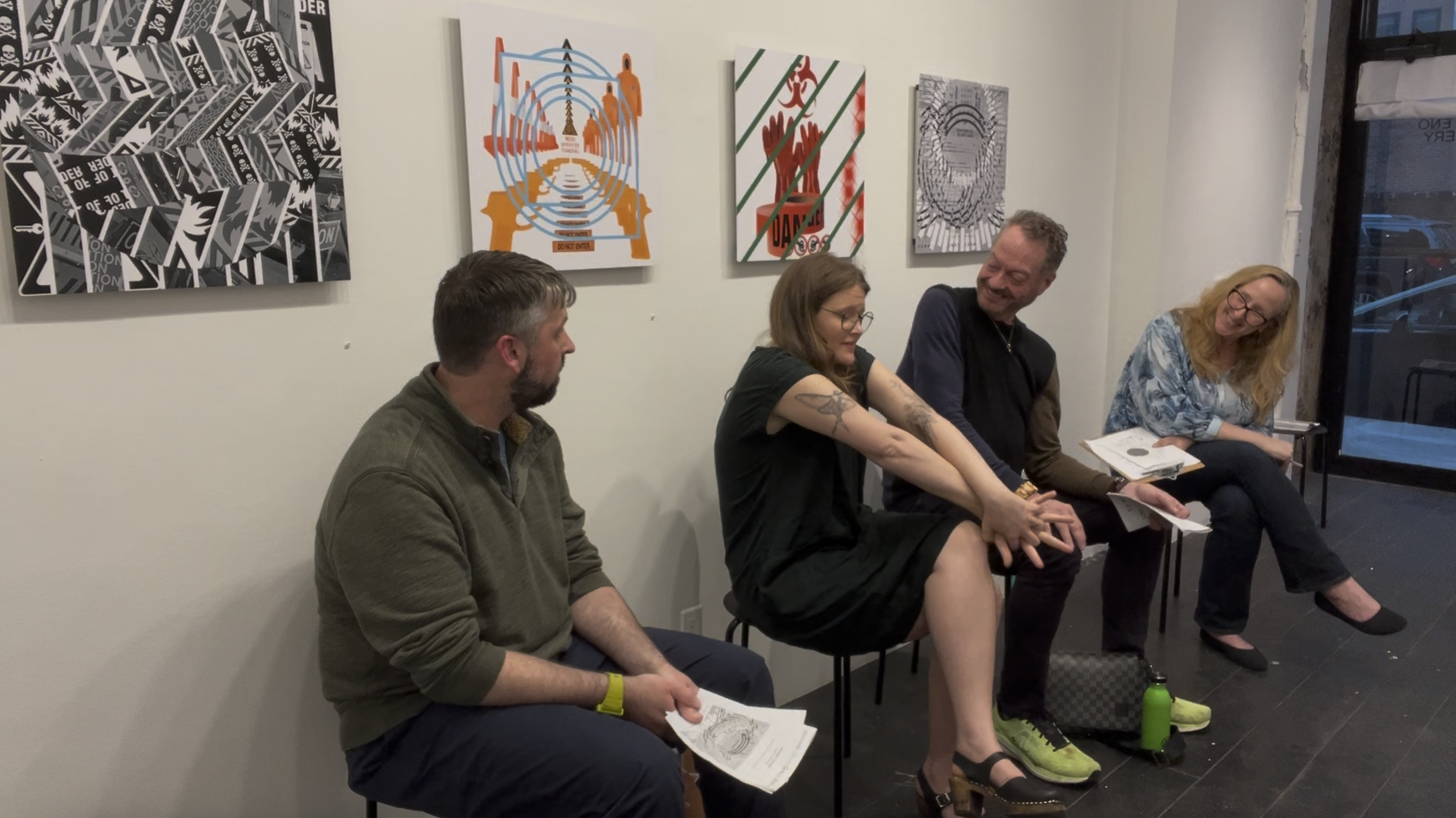
Julianne: My theme is really all growing from the same place. But I would say I am doing more research as to what is going on in the landscape or what’s going on politically, culturally, historically in the landscape. I guess previously I’d see something wrong with the landscape and I’d document it and make a picture about something very specific. Now I’m trying to have it be much broader, less literal I guess.
Audience: Your work also changed.
James: I started my MFA when I was in my early 40s. It took me another twenty years to get to being a full-time artist, so it’s not easy. I was doing a lot of figurative work and some abstraction. I was kind of influenced by my professor in my MFA program. I was doing figurative, then grotesquing the figure some. Now I’ve gotten back to more naturalistic than abstraction. It’s funny, I was in a Louis Vuitton store today and you were bringing up abstraction and I was seeing these abstract… you know, they have real artwork there… and I was like it would be so cool to be minimal, so who knows.
Aaron: Are you the next Louis Vuitton artist?
Ellen: Yeah!
James: No!
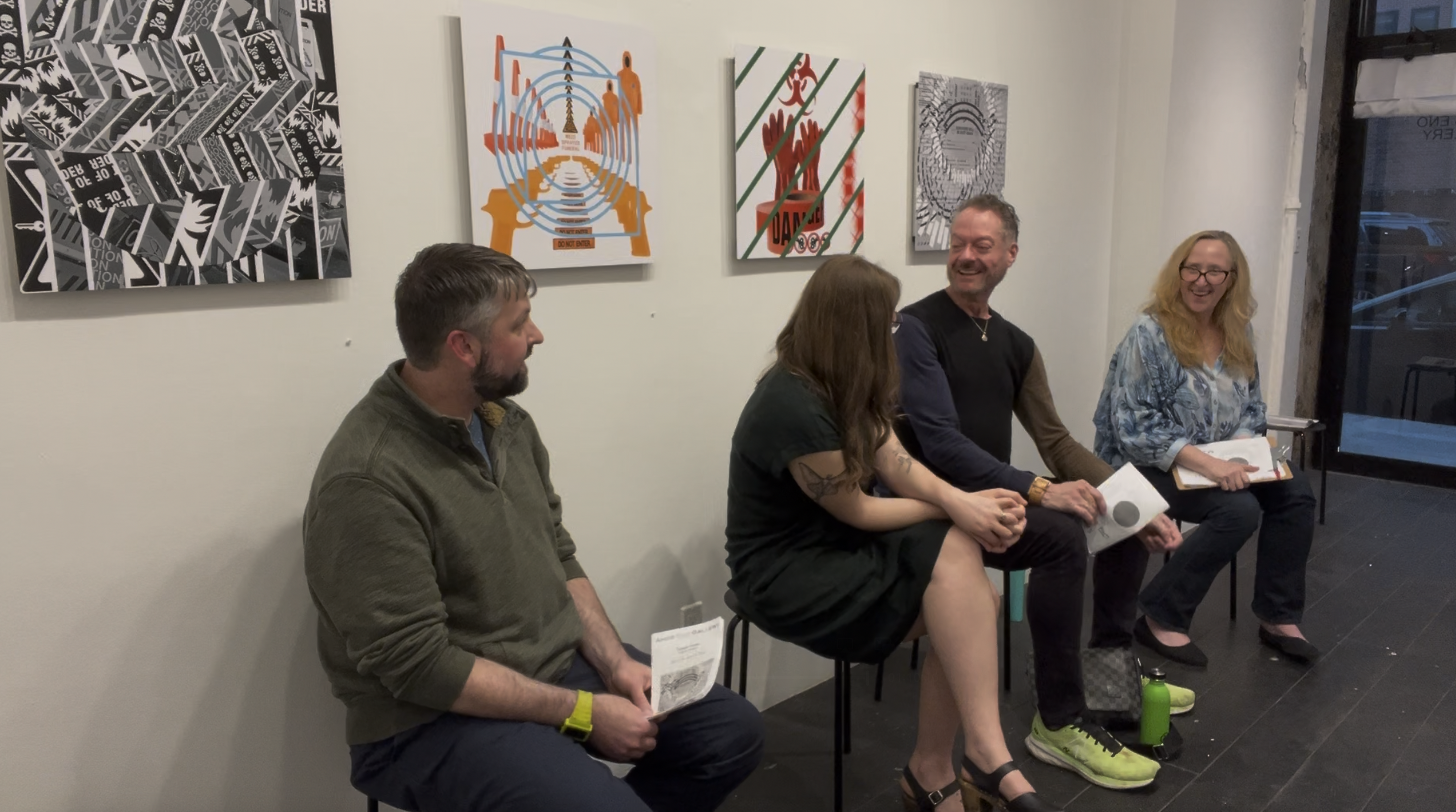
Ellen: Well, thank you all for coming! And thank you to our panelists: Aaron, Julianne, and James.
Aaron: Thank you for moderating!
James: Yeah, you did the hard part!
Ellen: Thank you for having me! We’re going to mingle a little bit, so please, if you haven’t had a chance to look at Aaron’s exhibition, take a look around. We’ll turn on the video in the back so you can see.
Aaron: There are some beverages as well.
Ellen: There are beverages back there. So, thank you very much.
James: Cool.
